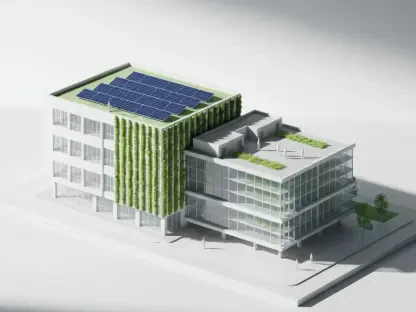In the current economic landscape, characterized by rising interest rates and cautious consumer spending, Pool Corporation (NASDAPOOL) stands out as a beacon of resilience. The company’s recent second-quarter earnings offer a detailed understanding of how it navigates economic challenges while continuing to sustain its revenue and meet Wall Street expectations. During Q2 2025, despite stagnant sales figures, Pool Corporation managed to deliver earnings per share (EPS) that exceeded analyst predictions. This accomplishment is largely attributed to the sustained demand for maintenance products, notably private-label chemicals, which counterbalances the decline in new pool constructions. The company’s strategies are instrumental in molding its financial health, presenting a narrative of strength even when faced with macroeconomic adversities.
Consistent Performance and Strategic Focus
One of the striking aspects of Pool Corporation’s Q2 performance is its ability to maintain steady revenue figures at $1.78 billion amidst economic headwinds. This stability was achieved through a focused strategy on sales of maintenance products, a sector marked by relentless demand. The corporation’s keen emphasis on private-label chemicals has emerged as a formidable stabilizer, effectively mitigating the drop in sales caused by decreased construction due to high interest rates. Pool Corporation’s adept handling of its portfolio ensures that EPS expectations are met, with a GAAP profit per share of $5.17—itself a remarkable 1.2% increase over projections. This is indicative of prudent management practices, with a clear-eyed view of the fluctuating economy.
The flat sales growth signals a carefully managed balance rather than volatility and showcases management’s capability in navigating economic uncertainty. Maintenance products, particularly in the chemical domain, offer predictable revenue streams aligned with existing pool bases. This reliability in demand circumvents the cyclical ebb and flow associated with construction activities. The company’s approach in capitalizing on maintenance supplies rather than overleveraging new constructions underscores an intelligence rooted in sustaining financial resilience through strategic asset management. Pool Corporation’s refined focus on discretionary segments that promise stability amidst unstable economic tides hints at future-proof strategies.
Regional Market Dynamics
Regional variability in Pool Corporation’s performance reveals diverse stories across geographical markets. States like Florida and Arizona remain bright spots on the map, driven by favorable climatic conditions and demographic trends such as population influx. These areas exhibit encouraging sales figures due to continued demand supported by constant pool use and maintenance. Conversely, regions such as Texas and California pose challenges, where these areas face slower sales growth tied to economic obstacles and reduced demand for new pools. This disparity highlights the influential role environmental and demographic factors play in Pool Corporation’s operations.
Nonetheless, the demand for maintenance holds steady across these underperforming areas, demonstrating the value of the company’s existing pool base. Even as discretionary spending on new constructions slows, the persisting maintenance needs emphasize the importance of non-cyclical revenue streams. The consistent sales in maintenance amidst geographic adversities point to an invaluable established pool infrastructure that anchors Pool Corporation’s ability to navigate diverse markets. By understanding and adapting to local trends and specific challenges, the company tactically positions itself to maintain its competitive edge and financial performance across multiple regions.
Maintenance Products as a Cornerstone
Serving as a financial backbone, maintenance products are pivotal in Pool Corporation’s enduring strength. The company benefits from robust gross margins, kept at a consistent level of 30%, thanks to improved supply chain dynamics, increased penetration of private-label goods, and strategic pricing maneuvers. The sustainability of demand for maintenance and repair services insulates the firm against the economy’s cyclicality more effectively than new construction projects. Stable margins further enable Pool Corporation to weather economic fluctuations by providing a reliable revenue base that compensates for the downswings in construction demand.
The retention of strong margins demonstrated in the financial results underpins Pool’s ability to maintain profitability. This is facilitated by a diverse product portfolio tailored to meet enduring market needs and executing strategic pricing that aligns with customer expectations. Moreover, the company’s adept management of supply chains and product positioning illustrates its commitment to protecting margins from macroeconomic pressures. Pool’s prudence in fortifying maintenance product sales not only provides financial stability but also contributes to a dynamic business model that aligns with long-term growth aspirations amidst economic volatility.
Strategic Initiatives and Growth Avenues
In addition to operational focus, Pool Corporation embarks on strategic initiatives such as digital transformation and network expansion. The rise in digital transactions through POOL360 marks a significant leap in operational effectiveness, growing from 14.5% to 17% of net sales. This digital adoption accelerates efficiency, positioning Pool Corporation at the forefront of technological advancement in distribution. It enables streamlined processes, reducing overheads, and enhancing customer interaction in a challenging landscape that demands agility. These improvements crystallize Pool Corporation’s competitive advantage, setting a foundation for sustained success others may struggle to mimic.
Apart from technological advances, physical network expansion also forms a cornerstone of Pool’s strategic drive. This is evidenced by new branch openings and wider franchising efforts such as Pinch A Penny’s move into markets like North Carolina. These physical expansions intend to fortify its market presence, capturing long-term market share. By merging digital prowess with expansive physical networks, Pool Corporation fosters a business model poised for comprehensive reach—a strategy reflecting deep cognizance of evolving consumer dynamics and long-standing demand. The harmonization of these strategies affirms Pool’s commitment to superior market positioning amid economic fluctuations.
Future Outlook and Market Challenges
Looking ahead, Pool Corporation’s management identifies key drivers impacting future performance. The underlying demand for maintenance remains resilient, indicating sustained sales revenues. Strict pricing strategies and tariff influences continue to support sales volumes and margins, yet challenges persist as chemical pricing deflations and normalization in building materials prices emerge. The company anticipates that while tariffs have absorbed market adjustments, these factors could create a complex pricing environment. Such an outlook underscores strategic vigilance in maintaining operational effectiveness while navigating intricate pricing landscapes.
Furthermore, the narrative surrounding construction and renovation activities remains cautious. Pool Corporation recognizes that enduring high interest rates and sluggish housing turnover continue to hinder new pool projects and significant renovations. Management conservatively views construction activity, awaiting macroeconomic catalysts like reduced interest rates to spur recovery. This measured approach reflects Pool’s preference for bolstering core strengths amid uncertainties, safeguarding its financial health. Insights into these challenges spotlight areas for proactive adjustments within Pool’s strategic framework as the company steers through a multifaceted economic journey.
Navigating Economic Environments with Resilience
Pool Corporation’s Q2 performance is notable for its ability to sustain revenue at $1.78 billion despite economic challenges. This achievement arises from a focused strategy centering around maintenance product sales, an area consistently in demand. Particularly, the corporation’s concentration on private-label chemicals serves as a stabilizing force, effectively offsetting sales drops from reduced construction activity due to high interest rates. Their adept portfolio management has ensured EPS expectations are met, posting a GAAP profit per share of $5.17—a commendable 1.2% above forecasts, showcasing strategic management acumen in a fluctuating economy.
The company’s stability in sales signifies a thoughtful balance, highlighting management’s proficiency in navigating uncertain economic environments. Maintenance products, especially chemicals, offer a reliable revenue stream linked to existing pool bases, bypassing the unpredictability tied to construction cycles. Choosing to focus on maintenance rather than new builds demonstrates financial resilience, ensuring future-proof strategies in an unstable economy by emphasizing segments that promise stability.









